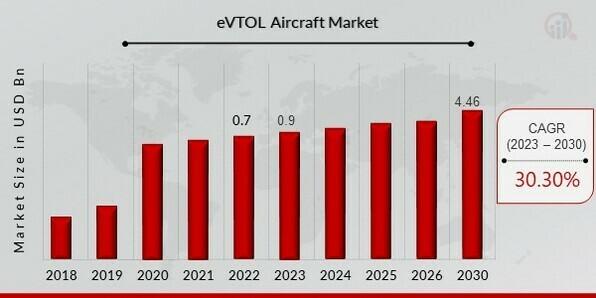Europe eVTOL Aircraft Market Size Key Players Research: Statistical Analysis (2024-2032)

Europe eVTOL Aircraft Market
The European market for electric Vertical Take-Off and Landing (eVTOL) aircraft is rapidly evolving, driven by technological innovation, regulatory initiatives, and a strong focus on sustainability. eVTOLs represent a transformative shift in urban mobility, promising to alleviate congestion, reduce emissions, and offer new modes of transportation. This article delves into the dynamics, opportunities, and challenges within the European eVTOL market.
Market Dynamics
Technological Advancements
Europe is witnessing significant advancements in eVTOL technology. Innovations in battery systems, electric propulsion, and autonomous flight controls are key drivers. Companies like Volocopter, Lilium, and Vertical Aerospace are leading the charge with cutting-edge designs and prototypes. These advancements are crucial for addressing technical challenges such as energy density, flight range, and safety, thereby enhancing the viability of eVTOL operations in urban environments.
Investment and Funding
The European eVTOL market is attracting substantial investment from venture capital, private equity, and traditional aerospace firms. For instance, Lilium has secured over $1 billion in funding, including investments from Tencent and Atomico. Volocopter has also attracted significant capital, with backing from Daimler and Intel. These investments are essential for accelerating development, scaling production, and navigating the complex regulatory landscape.
Regulatory Environment
The European Union Aviation Safety Agency (EASA) is playing a pivotal role in shaping the regulatory framework for eVTOL aircraft. EASA's Special Condition for VTOL aircraft provides guidelines for certification, ensuring safety and performance standards. Additionally, initiatives like the Urban Air Mobility (UAM) Initiative under the European Innovation Partnership on Smart Cities and Communities (EIP-SCC) are fostering collaboration between cities, industry, and regulators. This supportive regulatory environment is critical for the successful integration of eVTOLs into European airspace.
Market Opportunities
Urban Air Mobility
Urban air mobility presents a significant opportunity for eVTOL aircraft in Europe. Major cities such as Paris, London, and Frankfurt are ideal candidates for eVTOL deployment, offering solutions to urban congestion and providing efficient transportation alternatives. Companies are exploring potential routes and partnerships with municipal authorities to develop infrastructure and operational frameworks. The prospect of on-demand air taxis and air shuttle services is becoming increasingly viable.
Environmental Sustainability
Environmental sustainability is a core driver for the European eVTOL market. With stringent emissions regulations and a strong focus on green technologies, eVTOLs offer a zero-emission alternative to traditional aircraft and ground vehicles. This aligns with the European Green Deal and broader efforts to reduce carbon footprints and combat climate change. The transition to electric propulsion not only lowers operational costs but also appeals to environmentally conscious consumers and businesses.
Advanced Air Mobility (AAM) Ecosystem
The development of an Advanced Air Mobility (AAM) ecosystem is a multifaceted opportunity. This includes establishing vertiports (eVTOL landing and takeoff sites), charging infrastructure, and air traffic management systems tailored for eVTOL operations. Collaborations between eVTOL manufacturers, infrastructure developers, and technology providers are essential in creating a seamless AAM network. Europe, with its technological innovation and regulatory support, is well-positioned to lead in building this ecosystem.
Market Challenges
Technical and Safety Challenges
Despite progress, several technical and safety challenges persist. Ensuring the reliability and safety of eVTOL aircraft in diverse weather conditions, achieving efficient energy management, and developing robust autonomous flight capabilities are ongoing challenges. Additionally, public acceptance and trust in eVTOL technology will be crucial, necessitating rigorous testing and transparent communication about safety protocols and operational standards.
Infrastructure Development
The development of necessary infrastructure, such as vertiports and charging stations, is a significant challenge. Urban planning, regulatory approvals, and community engagement are complex processes that require coordinated efforts from multiple stakeholders. Integrating eVTOL operations with existing transportation systems and urban landscapes demands innovative solutions and substantial investment.
Regulatory and Certification Processes
Navigating the regulatory and certification landscape is another formidable challenge. EASA and other regulatory bodies are still defining comprehensive guidelines for eVTOL certification, airworthiness, and operational standards. Achieving regulatory approval requires stringent compliance with safety and performance criteria, which can be time-consuming and costly. Collaborative efforts between regulators and industry players are essential to streamline these processes and facilitate timely market entry.
Conclusion
The European eVTOL aircraft market holds significant potential, driven by technological innovation, investment, and regulatory support. While challenges remain, the opportunities presented by urban air mobility, environmental sustainability, and the development of an advanced air mobility ecosystem are considerable. As the industry progresses, Europe is poised to become a global leader in the eVTOL sector, transforming urban transportation and contributing to a greener future.
Contact us:
Market Research Future (part of Wantstats Research and Media Private Limited),
99 Hudson Street,5Th Floor New York 10013, United States of America
Sales: +1 628 258 0071 (US) +44 2035 002 764 (UK)
- Art
- Causes
- Crafts
- Dance
- Drinks
- Film
- Fitness
- Food
- Juegos
- Gardening
- Health
- Home
- Literature
- Music
- Networking
- Other
- Party
- Religion
- Shopping
- Sports
- Theater
- Wellness


